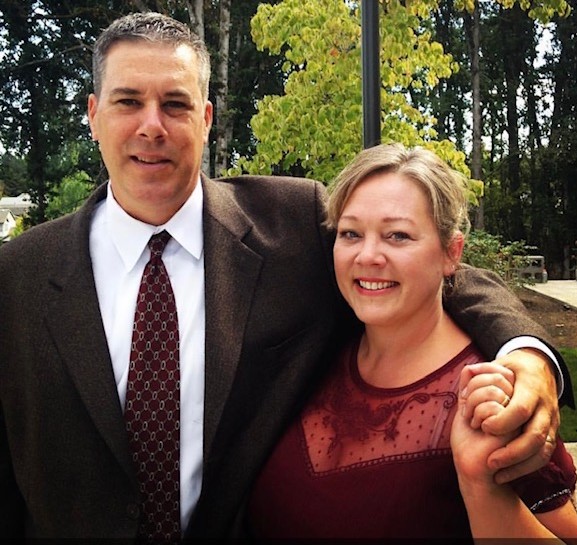 When 54-year-old Darin was diagnosed with head and neck cancer, he knew he was in for a fight. He readied himself for the surgery and weeks of radiation therapy that would follow. Darin was determined to do whatever it would take to get well.
When 54-year-old Darin was diagnosed with head and neck cancer, he knew he was in for a fight. He readied himself for the surgery and weeks of radiation therapy that would follow. Darin was determined to do whatever it would take to get well.
What he didn’t count on was his own stubbornness nearly getting in the way of his recovery. It’s this lesson Darin is determined to share, particularly with other men, who are more than twice as likely to get head and neck cancers than women.
The first challenge Darin faced was recovering from surgery to remove a tumor from his tongue and neck. Eating was difficult and painful, but with some “tough love” encouragement from a dietitian, he was soon eating graham crackers, applesauce, and other soft foods.
“And then just as I was recovering from surgery and putting on weight, it was time for radiation,” recalls Darin. “My type of cancer required 35 visits. I started off well, but soon had blisters in my mouth and throat that made it really difficult to chew and swallow.”
Within days, Darin could only tolerate blended food shakes. His wife, Kristy, did all she could to pack them with calories, including adding olive oil and peanut butter. Darin’s weight, however, started dropping quickly.
“I lost energy and felt weak. I looked skinny and feeble and was painfully dehydrated,” says Darin. In one week, he lost an alarming seven pounds.
Darin had been told from the beginning that eating might become difficult and that there was an option to have a feeding tube inserted into his stomach. “Trying to do without it was, in my mind, part of the mindset you need when battling cancer,” remembers Darin. After losing nearly 40 pounds, however, Darin recognized he needed to rethink his battle plan. If a G-tube could provide the nutrition he needed—then he should have one.
Fortunately, Darin is a decisive man of action. If he had waited much longer, he might be sharing a different story.
Patients who don’t get enough nutrition face a harder and longer road to recovery, including additional hospital stays. Significant weight loss can interrupt radiation treatment if the mask used to pinpoint the radiation has to be resized to fit a thinner face and neck. Severe malnutrition can also alter metabolism and lead to refeeding syndrome.
Darin says having the feeding tube placed was a fairly painless and quick procedure. After what he calls a slight learning curve, he was “eating” on his own. “I’d sit back in the recliner, hook up the bag, and be done in 15 minutes.” Darin’s energy returned, and he eventually began gaining weight.
“I was worried I wouldn’t be able to do the things I liked to with a feeding tube in, but that was not the case. I went to a few weddings and spent time on a ranch with my family. Things were fairly normal other than having to plug in my bag when we stopped for lunch or dinner.”
Darin was gradually able to eat solid foods again, and after four months, the G-tube was removed.
“My wife and my daughter, Riley, were my rocks,” says Darin. “And having a feeding tube was the key to my recovery and survival.”
 Darin’s cancer is now in remission. He’s back at work coordinating low-voltage electrical needs for hospitals and clinics in Oregon and enjoying life with his “wonderful wife, three children, and four grandchildren.”
Darin’s cancer is now in remission. He’s back at work coordinating low-voltage electrical needs for hospitals and clinics in Oregon and enjoying life with his “wonderful wife, three children, and four grandchildren.”
Darin also has a new mission—reaching out and counseling other men fighting head and neck cancer.
“Many farmers, ranchers, and men who love the outdoors live in Oregon. And they might be as stubborn as I was,” worries Darin. The advice he gives: Don’t delay in taking advantage of the strength and energy delivered by a G-tube.
Reinforcing a Critical Message
Darin’s radiation therapy dietitian, Kelly, is delighted to have a strong ally in explaining the benefits of enteral nutrition. “I see a lot of middle-aged men like Darin. They’re tough guys.” She tells patients what to expect from their treatment and stresses how important nutrition is in their recovery. Fatigue, Kelly explains, goes along with radiation. Patients who can’t eat are even more tired and miserable.
“It’s important for patients to understand that a feeding tube is a temporary intervention,” Kelly says. “I talk about goals—the temporary goals of getting through treatment and recovering while maintaining weight, managing symptoms, and staying hydrated.”
The G-tube can be removed when patients can maintain their weight for two weeks by eating normally, without enteral feeding.
Darin hopes his story and down-on-the-farm photograph will help dispel some of the worries and concerns other head and neck cancer patients may have about opting to use a G-tube. “Your body truly does need food to recover,” says Darin. “Food is fuel for the fight.”
Read more patient stories.